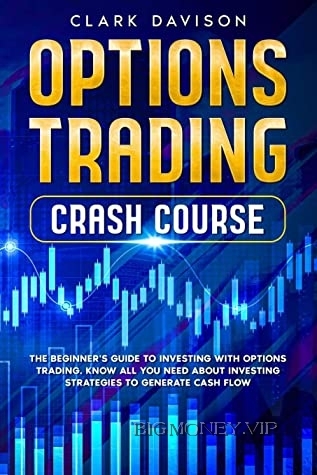OPTIONS TRADING CRASH COURSE: The Beginner’s Guide to Investing with Options Trading. Know All You Need About Investing Strategies to Generate Cash Flow by Clark Davison

CHAPTER ONE
WHAT IS AN OPTION?
Options are financial instruments dependent on the valuation of underlying
securities such as stocks, which are derivatives. An option contract gives
the buyer the ability to purchase or sell the underlying asset, depending on
the agreement they possess. Unlike futures, if they choose not to, the buyer
is not forced to buy or sell the asset.
Call options help the holder to purchase the asset within a
particular timeframe at a specified price.
Put options enable the holder to sell the asset within a specific
timeframe at a stated price.
Each option agreement will have a fixed expiry date by which the holder is
expected to exercise his or her option. The specified price is regarded as the
strike price for an option. Options are usually acquired and sold by brokers
that are online or retail.
Understanding Options
A flexible financial commodity is Options. These deals have a buyer and a
seller, where the first pays a premium for the rights given by the contract for
options. There is a bullish buyer and a bearish seller for each call option,
while a bearish buyer and a bullish seller have put options.
Option contracts normally represent 100 shares of the underlying security,
and for each contract, the buyer may pay a premium charge. For instance, if
an option has a premium of 35 cents per contract, it will cost $35 ($0.35 x
100 = $35) to purchase one option. The premium is partly dependent on the
strike price, until the expiry date, the price for buying or selling the safe.
The expiration date is another factor in the premium amount. The expiry
date specifies the day the option contract must be used, just as with the milk
carton in the refrigerator. The underlying asset will determine a use-by date.
For inventories, it is usually the third Friday of the month of the agreement.
For various reasons, traders and investors will purchase and sell options.
Speculation of options enables an investor to hold a leveraged stake in an
asset at a lower cost than purchasing its shares. Investors can use options to
hedge or lower their portfolio's risk exposure. In certain situations, when
they buy call options or become an option writer, the option holder will
produce income. One of the most direct methods to invest in oil is also
through options. The regular trading volume of the investment and open
interest for options traders are the two main numbers to watch to make the
most well-informed investment decisions.
American options may be applied at any time before the expiry date of the
contract. In contrast, European options may be exercised either on the date
of expiry or the exercise date. Exercising involves using the right to
purchase the underlying security or sell it.
Option Risk Metrics: The Greeks
'Greeks' is a term regarding the options market to describe the various
aspects of the risk involved in the positioning of an option, in a single
option, or a portfolio of options. Since they are usually identified with
Greek symbols, these variables are called Greeks. Each risk variable is a
consequence of the option's flawed assumption or interaction with another
underlying variable. To determine option risk and control option portfolios,
traders use various Greek values, such as delta, Theta, etc.
THE DELTA
Delta (Δ) reflects the rate of change between the option's price and a $1
change in the underlying asset price. In other words, the option's price
sensitivity is proportional to the underlying option. A call option's delta has
a range between zero and one, while a put option's delta has a range
between zero and negative. Assume, for instance, that an investor has a long
call option with a delta of 0.50. Thus if the underlying stock rises by $1, the
option's price will potentially increase by 50 cents.
Delta also reflects the hedge ratio for options traders to establish a delta-
neutral position. For example, you would need to sell 40 shares of stock to
be entirely hedged if you buy a regular American call option with a 0.40
delta. A net delta for a portfolio of options can also be used to obtain the
portfolio's hedge ratio.
The current probability that it will expire in-the-money is a less common
use of an option's delta. For example, today, a 0.40 delta call option has an
implied 40 percent likelihood of finishing in-the-money.
THE THETA




